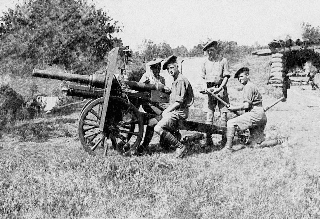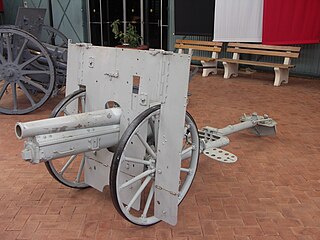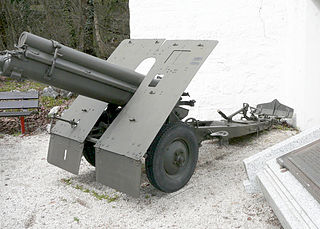 W
WThe 7 cm Gebirgsgeschütz M 75 was a mountain gun used by Austria-Hungary during World War I. Despite its 7 cm designation it actually fired a 66 mm (2.6 in) projectile. The Austro-Hungarian Army rounded up to the nearest centimeter for their designations. It was obsolete upon introduction as it had a bronze barrel and no recoil mechanism so it had to be relaid after every shot. The gun had an early form of Krupp horizontal sliding-block breech and it fired separate-loading, bagged charges and projectiles. Due to its low profile, its breech could recoil into the ground so its angle of elevation was restricted which was a significant handicap for a mountain gun which needed high angles of elevation. For transport, the Gebirgsgeschütz M 75 could be broken down into two loads.
 W
WThe 7 cm Gebirgsgeschütz M 99 was a mountain gun used by Austria-Hungary during World War I. It was obsolete upon introduction as it had a bronze barrel, a spring-loaded spade to absorb the recoil forces and it had to be relaid after every shot. The high elevations required of mountain guns greatly complicated the provision of barrel recoil systems as the breech could recoil into the ground, and it would be some years before satisfactory systems were developed. These would result in the 7 cm Gebirgsgeschütz M 8 and M 9 that used the same barrel and ammunition as the M 99, but had Gun shields and more advanced recoil systems. These guns weighed 402 kilograms (886 lb) and 456 kilograms (1,005 lb) respectively, although the exact differences between them are unclear other than they broke down into four and five loads for transport respectively.
 W
WThe 10 cm Gebirgshaubitze M 8 was a mountain howitzer used by Austria-Hungary during World War I. It was the first Austrian howitzer to use a modern hydraulic variable-recoil system. It used the same ammunition as the earlier 10 cm Gebirgshaubitze M 99, which was shown to be accurate, but lacked sufficient power to destroy bunkers, during World War I. It had a gun shield. It could be mounted on a special sled carriage designated 10 cm M. 8 Gebirgsschleife designed to allow for high-angle fire between +43° and 70° elevation. This sled was transported on a special bedding cart with removable wheels. The wheels were removed when in position to fire.
 W
WThe 10 cm Gebirgshaubitze M 99 was a mountain howitzer used by Austria-Hungary during World War I. It consisted of the bronze barrel of the 10 cm Feldhaubitze M 99 on a new, narrow-gauge box trail carriage that could be broken down for transport on animal carts. Like its brother, it lacked a modern recoil system, using only an ineffective spring-mounted recoil spade, and was virtually obsolescent upon its introduction. Relatively few were made as the version of the standard 10 cm Feldhaubitze M 99 with a narrow, 1.3-metre (51 in) carriage was cheaper.
 W
WThe Ordnance BL 2.75-inch mountain gun was a screw gun designed for and used by the Indian Mountain Artillery into World War I.
 W
WThe Ordnance BL 10 pounder mountain gun was developed as a BL successor to the RML 2.5 inch screw gun which was outclassed in the Second Boer War.
 W
WThe Canon de 76 M(montagne) modele 1909 Schneider was a mountain gun manufactured by a French company, Schneider. An earlier version, the 75 mm Schneider-Danglis 06/09 had been designed, in 1906, by a Greek officer, who designed it as a 75 mm gun. This gun was used by Greece who, by 1939, had sold 40 of these guns to Finland, where it was known as the 75 LK 13.
 W
WThe Ehrhardt 7.5 cm Model 1904 mountain guns were originally issued to the Schutztruppe in German South-West Africa. The gun was also issued to the Portuguese colonial forces in Angola.
 W
WThe QF 2.95-inch mountain gun was the designation given by the British to a Vickers 75 mm calibre gun. It was originally produced for the Egyptian Army. It was taken into British service in the late 19th century to provide the 'movable armament' at some coaling stations. Also known as 'The Millimetre Gun', it was used by the West African Frontier Force in several theatres in Africa during World War I. It was also used by United States and Philippines.
 W
WOrdnance, QF 3.7-inch howitzer is a mountain gun, used by British and Commonwealth armies in the First and Second World Wars, and between the wars.
 W
WThe Skoda 7.5 cm Gebirgskanone M. 15 was a mountain gun used by Austria-Hungary in World War I. In German service, it was known as the 7.5 cm GebK 15. The Italians designated them as the Obice da 75/13 and the Wehrmacht would designate captured guns as 7.5 cm GebK 259(i) after the surrender of Italy in 1943.
 W
WThe Skoda 100 mm Model 1916 was a mountain howitzer used by Austria-Hungary during World War I. The Turks used a 105 mm variant, the M.16(T). The Wehrmacht redesignated this as the 10 cm GebH 16 or 16(ö). Guns acquired from Italy, after 1943, were known as 10 cm GebH 316(i); those acquired from Czechoslovakia were 10 cm GebH 16(t). The Italians referred to weapons gained either through capture or reparations as the Obice da 100/17 modello 16. The gun could be broken into three sections, intended for towing by two animal carts. The gun crew was protected by a gun shield. The Italians used lighter shells than the Czechs, which accounts for the greater range and muzzle velocity of their guns.